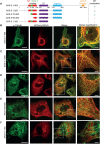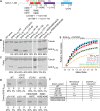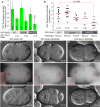Interaction between the Caenorhabditis elegans centriolar protein SAS-5 and microtubules facilitates organelle assembly
- PMID: 29367435
- PMCID: PMC6003225
- DOI: 10.1091/mbc.E17-06-0412
Interaction between the Caenorhabditis elegans centriolar protein SAS-5 and microtubules facilitates organelle assembly
Abstract
Centrioles are microtubule-based organelles that organize the microtubule network and seed the formation of cilia and flagella. New centrioles assemble through a stepwise process dependent notably on the centriolar protein SAS-5 in Caenorhabditis elegans SAS-5 and its functional homologues in other species form oligomers that bind the centriolar proteins SAS-6 and SAS-4, thereby forming an evolutionarily conserved structural core at the onset of organelle assembly. Here, we report a novel interaction of SAS-5 with microtubules. Microtubule binding requires SAS-5 oligomerization and a disordered protein segment that overlaps with the SAS-4 binding site. Combined in vitro and in vivo analysis of select mutants reveals that the SAS-5-microtubule interaction facilitates centriole assembly in C. elegans embryos. Our findings lead us to propose that the interdependence of SAS-5 oligomerization and microtubule binding reflects an avidity mechanism, which also strengthens SAS-5 associations with other centriole components and, thus, promotes organelle assembly.
© 2018 Bianchi, Rogala, Dynes, et al. This article is distributed by The American Society for Cell Biology under license from the author(s). Two months after publication it is available to the public under an Attribution–Noncommercial–Share Alike 3.0 Unported Creative Commons License (http://creativecommons.org/licenses/by-nc-sa/3.0).
Figures






Similar articles
-
SAS-4 is recruited to a dynamic structure in newly forming centrioles that is stabilized by the gamma-tubulin-mediated addition of centriolar microtubules.J Cell Biol. 2008 Feb 25;180(4):771-85. doi: 10.1083/jcb.200709102. J Cell Biol. 2008. PMID: 18299348 Free PMC article.
-
Sequential protein recruitment in C. elegans centriole formation.Curr Biol. 2006 Sep 19;16(18):1844-9. doi: 10.1016/j.cub.2006.07.059. Curr Biol. 2006. PMID: 16979563
-
Centriolar SAS-7 acts upstream of SPD-2 to regulate centriole assembly and pericentriolar material formation.Elife. 2017 Jan 16;6:e20353. doi: 10.7554/eLife.20353. Elife. 2017. PMID: 28092264 Free PMC article.
-
Towards a molecular architecture of centriole assembly.Nat Rev Mol Cell Biol. 2012 Jun 13;13(7):425-35. doi: 10.1038/nrm3373. Nat Rev Mol Cell Biol. 2012. PMID: 22691849 Review.
-
Centrosome size is controlled by centriolar SAS-4.Trends Cell Biol. 2003 Jul;13(7):340-3. doi: 10.1016/s0962-8924(03)00126-0. Trends Cell Biol. 2003. PMID: 12837604 Review.
Cited by
-
PLK4 promotes centriole duplication by phosphorylating STIL to link the procentriole cartwheel to the microtubule wall.Elife. 2019 May 22;8:e46054. doi: 10.7554/eLife.46054. Elife. 2019. PMID: 31115335 Free PMC article.
-
Molecular architecture of the C. elegans centriole.PLoS Biol. 2022 Sep 15;20(9):e3001784. doi: 10.1371/journal.pbio.3001784. eCollection 2022 Sep. PLoS Biol. 2022. PMID: 36107993 Free PMC article.
-
Autoamplification and Competition Drive Symmetry Breaking: Initiation of Centriole Duplication by the PLK4-STIL Network.iScience. 2018 Oct 26;8:222-235. doi: 10.1016/j.isci.2018.10.003. Epub 2018 Oct 11. iScience. 2018. PMID: 30340068 Free PMC article.
-
Revisiting Centrioles in Nematodes-Historic Findings and Current Topics.Cells. 2018 Aug 8;7(8):101. doi: 10.3390/cells7080101. Cells. 2018. PMID: 30096824 Free PMC article. Review.
-
A dynamically interacting flexible loop assists oligomerisation of the Caenorhabditis elegans centriolar protein SAS-6.Sci Rep. 2019 Mar 5;9(1):3526. doi: 10.1038/s41598-019-40294-2. Sci Rep. 2019. PMID: 30837637 Free PMC article.
References
Publication types
MeSH terms
Substances
Grants and funding
LinkOut - more resources
Full Text Sources
Other Literature Sources

